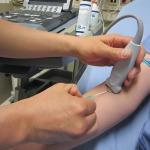A vein of truth: using ultrasound can help find the best IV access
 Vampires make it look easy on TV, but in reality, it’s not always easy finding a good vein. Health care providers rely on a visual examination to find the perfect vein for intravenous access; however, when working with children, obese patients, trauma patients or patients who have scarring from numerous IVs, it can be challenging.
Vampires make it look easy on TV, but in reality, it’s not always easy finding a good vein. Health care providers rely on a visual examination to find the perfect vein for intravenous access; however, when working with children, obese patients, trauma patients or patients who have scarring from numerous IVs, it can be challenging.
In a recently published New England Journal of Medicine video, Hennepin County Medical Center (HCMC) emergency physicians and nurses offer expertise in IV placement using ultrasound-guided techniques.
“When traditional techniques won’t work, we rely on ultrasound to help us visualize a vein with good potential for IV access,” explains Dr. Scott Joing. “It’s much easier to cannulate a vein you can see.”
The video outlines all the steps needed to successfully employ ultrasound guidance to place IVs, including various approaches (transverse, longitudinal), where to place and rotate the transducer, and common errors or complications to consider.
Watch the video at http://www.nejm.org/doi/full/10.1056/NEJMvcm1005951
HCMC’s emergency department has been a pioneer in the use of point-of-care ultrasound (see HCMC Network Feature, Dec. 16, 2011). A comprehensive academic medical center and public teaching hospital, HCMC was Minnesota’s first Level 1 Trauma Center and has the largest emergency department in the state.
[slideshow]

